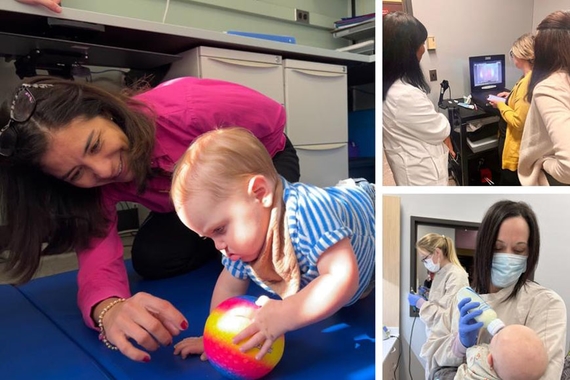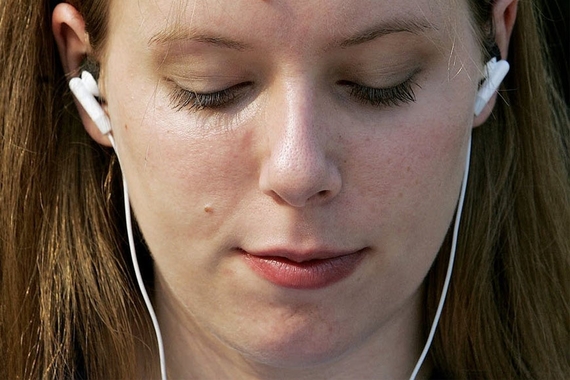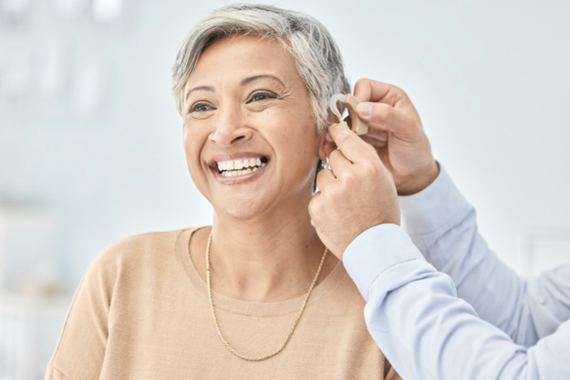Race and Language: Where Perceptions and Justice Intersect
Interview highlights have been lightly edited for length and clarity.
Dr. Alayo Tripp: My standard cocktail party explanation to people, at times that I avoid using a professional context usually, I feel just viscerally accessible to people when I explain it this way, is that my research is concerned with how people learn and understand the difference between someone saying, “that's f***ed up!” Or, “that's f***ed up.” Ostensibly, these are the same phrases. It's the same words in the same order. And yet you have a very strong intuition about what kind of person would say which one and how their meaning would be very fundamentally different.
How did the two of you end up working together?
Professor Benjamin Munson: I submitted this grant thinking that what was going to happen, is what usually happens to grants like this...that there are multiple rounds of revision, and that it's quite uncertain whether they're ever going to get funded. Much to my great surprise, it was funded in the first round and scored very, very favorably.
Immediately, I was thinking, “All right, I have to find the right person to work with on this grant.” And so I reached out to people in my professional network and said, “Do you know of anyone who would be appropriate to work on this grant, who would be interested, who would really enjoy the work and see it as an extension of what they'd already done?”
And a longtime colleague of mine, Jan Edwards, who is currently at the University of Maryland said, “We have the perfect person,” and put me in contact with Dr. Tripp., and really, the rest is history from my standpoint. I reached out to Dr. Tripp, They came up to interview, and it was, I think, a really good fit, and that's how we came to work together.
AT: I had this concept of Dr. Munson's interests, and I had a good sense that our interests would align beyond just this project, despite being a study of perception in adults and older adults, because it shares a lot of themes with the work that I’ve done in infants. We are both very interested in being able to tell a more complete developmental story about how the mental constructs that people use to navigate linguistic interactions develop, and what their structure is, and how they change over time.
How did you become interested in the connection between what we see and what we hear?
BM: This is something that was a part of the first decade of my life. When I went into college and eventually found speech-language-hearing sciences by way of linguistics, my thought was, “Well, I don't see this being talked about in my courses, and so this must not be a worthy area of study.”
There was certainly research on African American Language or African American Vernacular English, as it was generally referred to at the time. But this was always talked about as, “there's this variety of English that these people use, and it’s different from the other varieties in these ways.” People weren't really talking about the issues that were on my mind of how different language varieties could shape people’s understanding of a person, could sway people to interpret someone one way or another.
For a long time, I thought, “Well, this just isn't something that I can study.” And then I eventually finished my PhD on a topic very different from this, came to the University of Minnesota, and continued to pursue that topic very different from this. I realized that if I was going to eventually get tenure, which I did, I would have academic freedom, and I could parlay the successes that I had, the privilege that I have, the resources that I have, to stake out and start to look at these topics that I believed in the core of my soul were important and worthy of investigation. And those were the seeds of what you’re seeing in this line of research we've been talking about.
AT: When talking about the wealth of work that's been done on African American English, it’s important to mention that I often see it cited as one of the most studied varieties of English. And I think that it’s important to contextualize the reasons why people found it a necessary subject to study. Traditionally, it was studied as evidence of deficiency in the people who spoke it. And there are people who have researched it since who have taken on the goal of correcting those racist assumptions.
But underlying all of that wealth of work is this history of racism. I was very conscious of code-switching behavior when I was a child, I think partly owing to the fact that I am autistic. I was always very conscious of these choices that people were making and how effortlessly and intuitively they seemed to understand things I felt I always had to put effort into.
When I started my doctorate, I think I spent a long time shying away from the topics which interested me most because I was afraid of how they would be perceived.
How did you design the study to effectively explore the ideas you wanted to examine?
BM: The first thing that we had to do was figure out how we were going to collect masses of audiovisual speech data from people of various races and ethnicities. Initially, we designed a data elicitation protocol that we would’ve recorded in the sound booth and my laboratory in Shevlin Hall. After recording [just] two people in that protocol, COVID happened. WAnd so we really were wringing our hands because it was pretty evident from the early part of the pandemic that this was not going to be something that would be solved by summer's end.
With that in mind, Dr. Tripp came up with a really elegant data collection protocol for Zoom, one that I can say, as a member of the IRB (Institutional Review Board), other people are now using, not necessarily in terms of, not necessarily the specific types of data that we're recording, but in terms of things like the privacy controls and the protection of human subjects. This is all from Dr. Tripp.
AT: The experiment was reading a sentence to the participant, and asking them to repeat it back to us from memory because we don’t want them to sound like they're reading.
But we found that if we just do that, if I just read the sentence in a normal cadence and ask them to repeat it back, they mimic the experimenter’s cadence really closely. So we would supply the sentence with very odd prosody, or rhythm, and put emphasis on words that you might not expect, to guarantee that the participant wouldn’t want to mimic us because they would sound ridiculous.
I realized—when we were doing those first couple pilots, we were still in the lab at that time—that their tendency to mimic me was so strong that I couldn’t rely on the participants to provide their own pronunciation of even the words even. If I use the word “ant” instead of “aunt,” they would say it the way I said it, and I wouldn’t know how they would have otherwise said it. So providing the sentences in this distorted way really encouraged them to give us very natural productions.
Now that I’ve had to read every sentence to a participant several times over, I tend to have my favorite silly way of saying that sentence.
Did you find any surprising benefits or drawbacks to conducting this study online instead of in person?
BM: One of the nice things about collecting data over video conferencing is that we were able to engage people who wouldn’t necessarily have been engaged with research otherwise. So when we think about the way that people of color have been treated in research historically, I mean, some of the very reasons why we have institutional review boards are things like Tuskegee, right? And those scars run deep. That pain runs deep. And I think there was something about collecting data on video conferencing calls that gave people a little more comfort. They were joining us from the comfort and the safety of whatever space they wanted to join us from.
So we've recorded, and by “we” I really mean Dr. Tripp and their core of undergraduate research assistants, have recorded many dozens of people, and many dozens of people who are not white. And we have a core of undergraduates who are pulling out the target words and sentences that we will use in our speech perception experiments. So we’ll be in a position where we’ll be able to take those audiovisual sentences and put them in an online experiment that people will be able to do, again, from the safety of their own home.
Can you report anything on what you’re finding at this point?
BM: These sentences have been used in more socio-linguistics, more socially meaningful speech studies, but nobody’s ever really interrogated whether the sentences themselves are appropriate for those kinds of investigations. One thing that Dr. Tripp and I did early on in the project, shortly after they started, was a big online survey, with help from our colleagues in CLA LATIS. We took a set of these standard sentences and a set of sentences that we had culled from Reddit, sentences that were actually written by people engaging in social communication through Reddit chat boards, subreddits. Our IT colleagues in LATIS [Liberal Arts Technologies and Innovation Services] made a Qualtrics survey for us, and we used the platform Prolific Academic to have 120 people read these sentences.
For each sentence we had them answer the questions: How surprised would you be to find out that this sentence was produced by a man or by a woman? How surprised would you be to find out that the person who said this sentence was Black or white or South Asian or East Asian? And what we found was that for these standard sentences, a good 20 percent of them actually do elicit a strong social cue.
What makes your work unique or different from others in your field?
AT: Oftentimes, when researchers look at the effect of ethnic and racial differences, they confine their investigation to two or maybe three different categories. We set out to recruit from at least five different categories, but we’re not excluding any participants for their ethnicity. So if they don’t fit into those five categories, we have still included them in the study.
Can you describe the relationship between your research and your teaching?
BM: I hope that this kind of research, the kind of research that Dr. Tripp and I are doing, is attractive to a diverse group of students, because we need fewer people like me [a white male] making these statements and more people who can talk about them from a broader perspective, from their lived existence, as well as from a scholarly basis and sort of scholarship that they’ve done.
How does your work reflect, confront, or otherwise call attention to problems facing our society?
AT: There is systemic discrimination against numerous marginalized groups. And language is very closely associated with identity and how people present themselves as belonging to different groups. So I think that our work is really critical in understanding how this process of understanding each other can be shaped and possibly disrupted by our beliefs about these social factors.
BM: I would say that of the two problems that humans face right now, the two biggest problems that humans face right now are climate change and inequity. If we think about what Dr. Tripp just said, about the language that we use, the way we use language is intimately linked to our identities, both in ourselves and the agency that we exercise when we use varieties to show different aspects of our identity and affect the way people perceive us. Those can be primary factors to inequities.
If somebody is going to look at you and appraise you as different because of your language use, then we need to really understand the nuts and bolts of why and when that occurs, and how we can stop it.
AT: What I really love about being in this speech-language-hearing sciences department is the philosophy that speech-language-hearing sciences brings to communication as a human right. And that for all of the flaws in the discipline, this field exists to address disparities in access to communication.
I feel really excited to be on a project that's designed to create a resource that can be used long after we're done with the specific perception experiments that we proposed.
What’s next on the horizon?
BM: Once we finish this project on how race interacts with speech perception in older adults, we’re in a really good position to go back and look at these questions in development. Within development, one of the really important questions to ask is how children’'s performance on standardized measures that are administered with language, so standardized measures of language, are affected by the variety used by the person who's administering the test.
There’s this long-standing finding that kids who are economically disadvantaged have a word gap. When you measure their vocabulary size using standardized tests, they perform more poorly than kids who are not being raised in poverty. There are lots of questions to be asked here about how the variety of language that's being used in the test administration really drives this gap, and to be able to flip the question on its head and say, “Okay, if we take white kids and we give them these measures, and we use Black English, we use African-American English, and African-American language to test them, do they show the same kind of performance decrements that we see in these kids who are ostensibly sort of language deprived?” At least that’s the way that they’re characterized.


